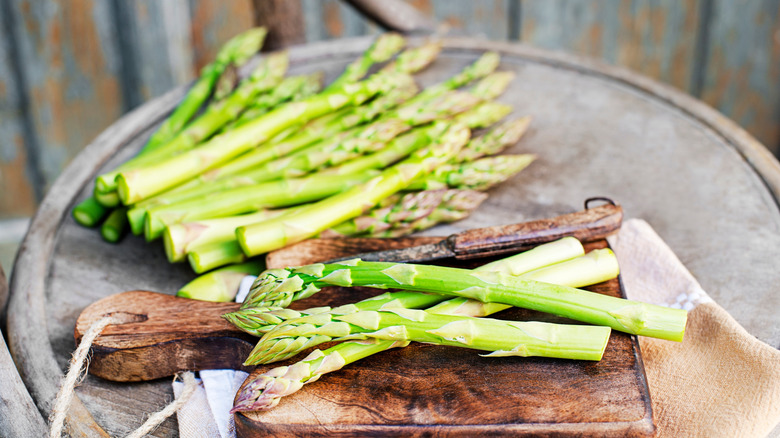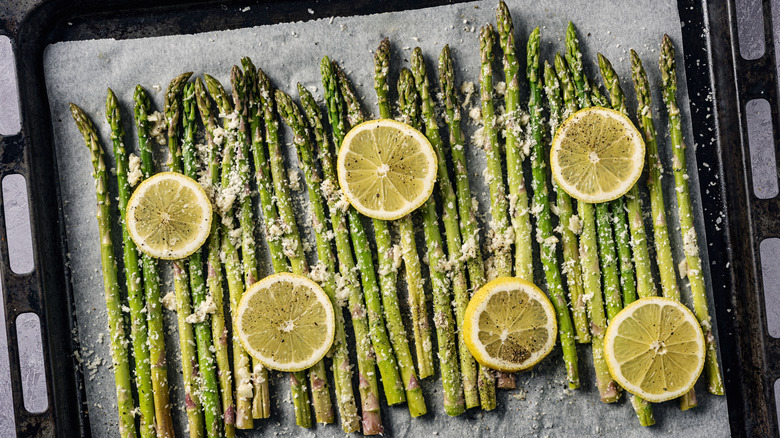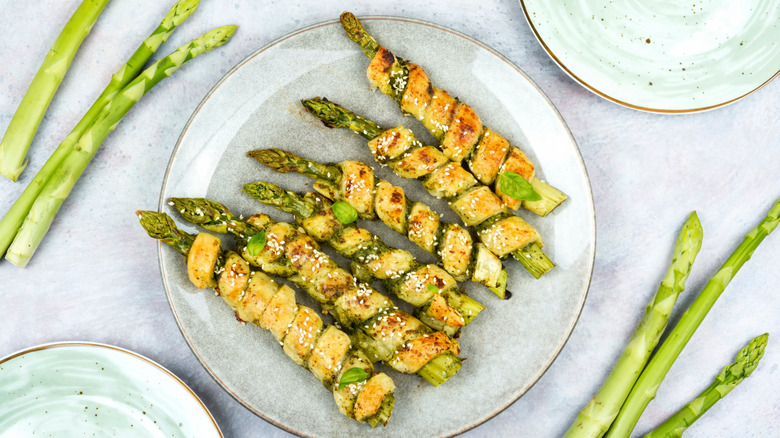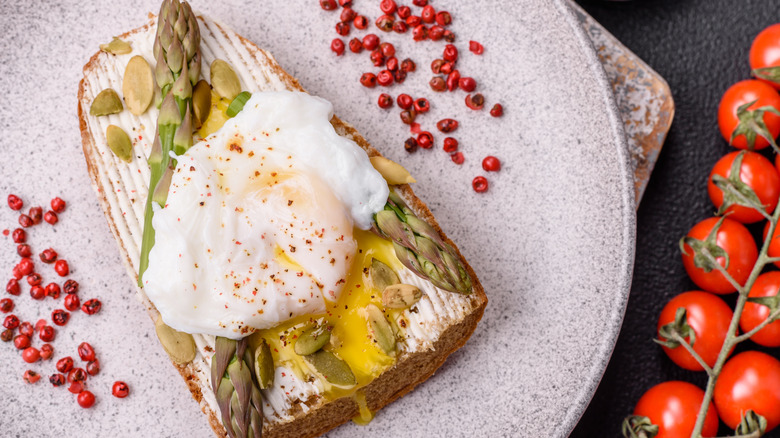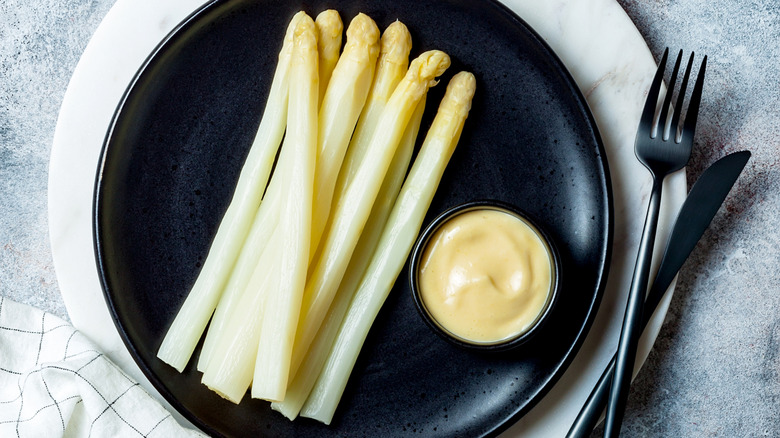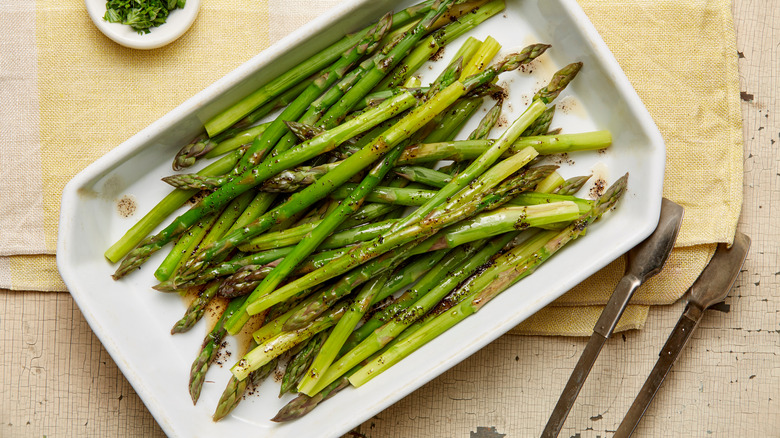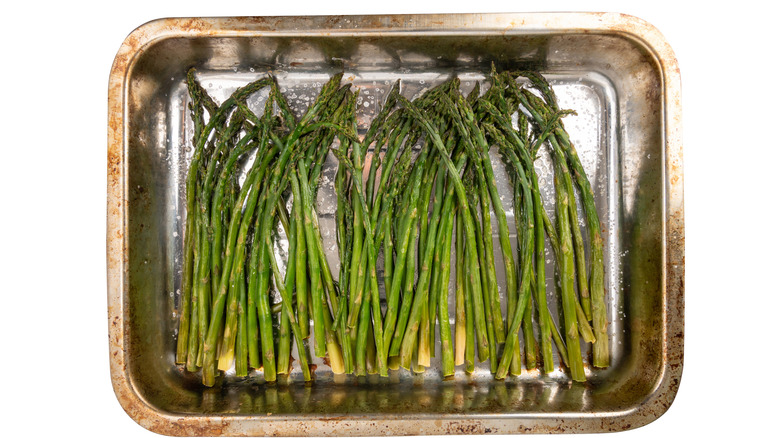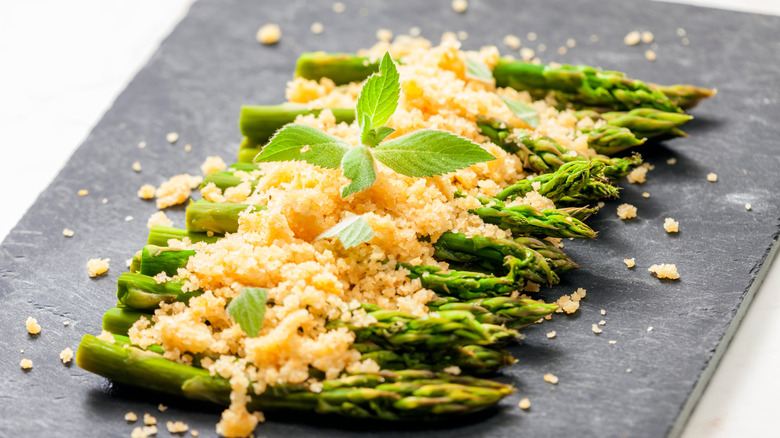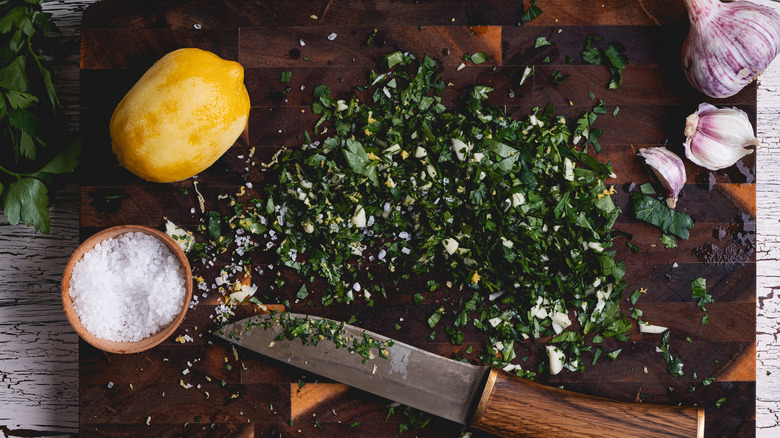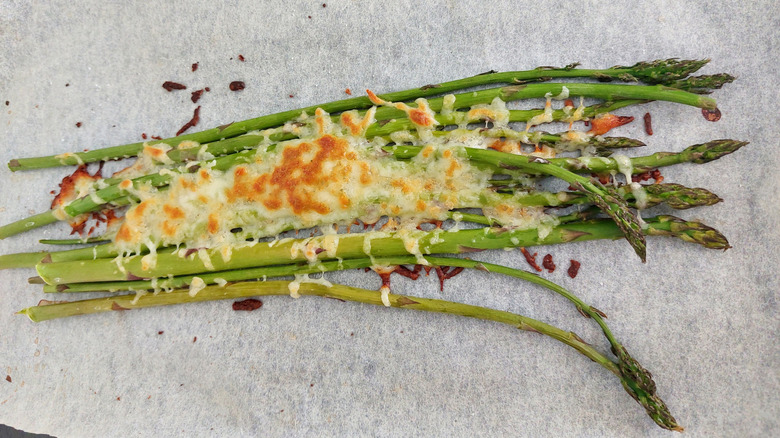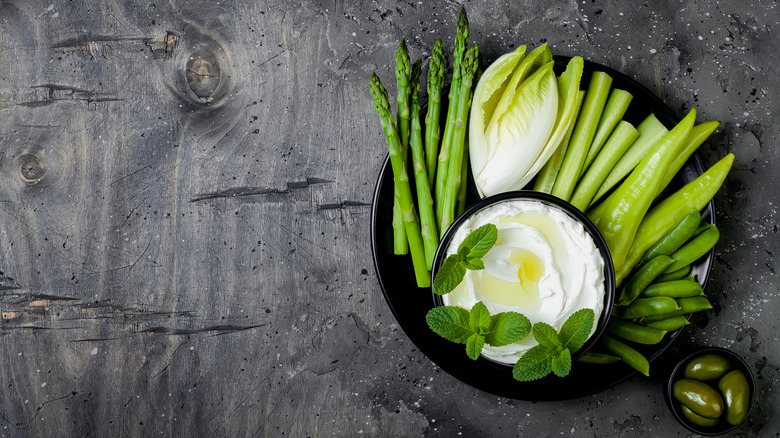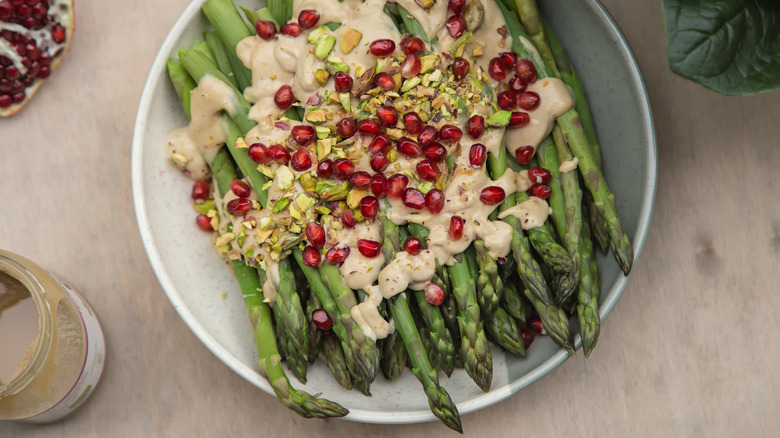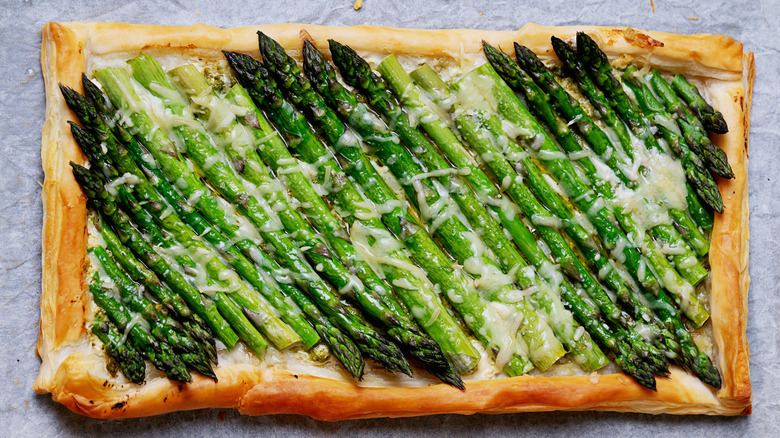14 Ways To Take Asparagus To The Next Level
Asparagus can be delicious prepared simply, either steamed or sauteed and served with a sprinkle of salt and pepper. However, this delicate veggie can get old after a while, especially when it's out of season and not at its most flavorful. Conversely, you might want to take asparagus to the next level when it is in season and you have a glut to use up, so you find yourself eating it frequently.
There are so many tweaks you can make and methods you can try to turn things up a notch. You might want to add extra ingredients, such as a drizzle of brown butter or a splodge of labneh, or maybe you'd rather serve it in new ways, like in tacos or wrapped in puff pastry. There are really no rules when it comes to this delicious spring vegetable. It's not too assertive to work in many types of dishes, yet it can still hold its own enough for its flavor to come through.
Veggies are often relegated to life as plain side dishes. But we're about to show you that asparagus can be way more exciting than this. You just have to get creative and not be afraid to try something new, and you'll be surprised how tasty the outcome is. Here are 14 ways to level up your asparagus that you need to try.
1. Add citrus zest or juice
Asparagus can often benefit from some brightness, so adding citrus zest or juice is an obvious choice. It can help lift the dish, however you've decided to prepare it. With citrus on your side, you get an extra zing that contrasts the subtle grassy taste and hint of bitterness.
Lemon is the obvious choice when reaching for citrus, such as in this lemony grilled asparagus recipe. It's something many keen cooks always have on hand, and it brings a slightly floral, sweet acidity to the finished dish. However, you can also opt for lime, which is a little less sweet and more bitter — perfect if you want to lean into the natural bitter notes of asparagus. Orange is another choice if you want a more assertive fruity flavor and less acidity.
While citrus juice brings a hint of sourness alongside sweet, fruity, and floral notes, the zest is sweeter and more fragrant without the sourness. It can be a nice addition along with the juice, so you get more of the citrus flavor without excess tang. Citrus works well with asparagus that's steamed, sauteed, roasted, grilled, blanched — however you want to serve it.
2. Wrap it in puff pastry
If you're stuck in an asparagus rut, wrapping it in puff pastry is a tasty way to make it feel brand new. It's basically a springtime take on pigs in a blanket, with tender green spears instead of sausages. And because it's easy to find good-quality ready-made puff pastry, it's super simple to pull off.
We love that this option adds both texture and richness. The crisp pastry gives the finished dish an extra dimension, while the butteriness makes it feel more indulgent. All you need to do is cut strips of puff pastry and wrap them around the stalk in a spiral. Add a smear of Dijon, chili jam, or herbed cream cheese before rolling to pack in extra flavor — though it's still delicious plain. A sprinkle of flaky smoked salt or grated Parmesan just before baking takes it even further.
What's more, this looks impressive, making it ideal for brunch spreads, spring gatherings, or potlucks. Puff pastry has a way of leveling up a recipe way more than the amount of effort it actually takes. So the next time you're eyeing that bunch of asparagus in the fridge, consider pairing it with puff pastry.
3. Top it with a poached egg
Another excellent way to level up asparagus is to top it with a poached egg. It's a classic pairing for a reason — the runny yolk acts like an instant sauce, coating the spears and pulling the dish together with very little effort. Sure, making the perfect poached egg can be a challenge, but once you've got that down, this dish is extremely easy. It turns asparagus from a side into a full light meal, and with a few slices of toast, you have yourself an excellent brunch.
The contrast in textures is part of what makes this dish work so well. You get the tender crunch of just-cooked asparagus against the softness of the egg, paired with the runny and unctuous yolk. You can even add seasoning — maybe a twist of black pepper, a pinch of flaky salt, or a dusting of smoked paprika.
This combo also opens the door to all kinds of variations. Spoon some hollandaise over top or sprinkle crispy breadcrumbs for added crunch. And while it's lovely as a brunch dish, it works just as well as a quick dinner when you're not too hungry and want something that feels nourishing but low-effort.
4. Dunk it in mayo
If you're looking for the simplest way to make asparagus feel more special, try dunking it in mayonnaise. We got this gem from J. Kenji López-Alt: After blanching or steaming the asparagus until just tender, let it cool slightly, then spear a stalk and dip it straight into a dollop of creamy mayo. He swears by his one-minute, homemade version of the condiment — bright with acid and rich with egg yolk — but even a good-quality store-bought mayo works in a pinch.
The juxtaposition of textures is what makes this so great. The creamy mayo coats each bite, balancing the snap of the lightly blanched asparagus. A grind of black pepper or a sprinkle of smoked paprika on top both add a hint of warmth. You could also stir in chopped fresh herbs or fold in a spoonful of sriracha to give it a kick. It might seem odd to just dunk asparagus in mayo, but trust us. And if you don't trust us, trust López-Alt's ridiculously straightforward and amazing suggestion.
5. Drizzle it in brown butter
Drizzling asparagus with brown butter is a quick way to transform it into something you might get served at a fancy restaurant. Brown butter — known in French as beurre noisette — is simply regular butter cooked gently until the milk solids toast and the liquid turns a warm, nutty brown. The process only takes a few minutes on the stovetop but yields a sauce brimming with toasty, nutty flavor. It's so delicious that you'll quickly realize you need to start using brown butter in your recipes.
To make it, melt a knob of unsalted butter in a light-colored pan over medium heat. Swirl it as it foams and watch carefully. The foam will subside, the butter will take on golden flecks, and you'll catch a toasted aroma. As soon as you see those tiny brown bits at the bottom of the pan, pull it off the heat to avoid burning.
While your asparagus cooks — steamed, roasted, or quickly sauteed — get your brown butter ready, then spoon it over the spears right before serving. Just a few minutes of extra prep work makes all the difference here, transforming this dish into something spectacular.
6. Roast it
Roasting asparagus takes its flavor a giant leap beyond what you get from steaming or blanching. When you roast the vegetable, the dry heat of the oven draws out moisture and encourages gentle browning — the Maillard reaction at work — which creates deep, almost nutty notes alongside the natural sweetness and grassy flavor. In contrast, steaming or simmering keeps flavors bright and fresh-tasting but can be one-dimensional.
To roast asparagus, preheat your oven to about 450 degrees Fahrenheit. Toss trimmed spears with a little olive oil, salt, and pepper so each one gets a light coating. Spread them in a single layer on a baking sheet — crowding will cause them to steam instead of roast. Thin spears need only about eight to 10 minutes, average ones require around 12 minutes, and thick ones should stay closer to 15 minutes in the oven to brown slightly without getting floppy.
As the asparagus roasts, the sugars caramelize and the water evaporates, concentrating flavors. A final squeeze of lemon or a shower of grated cheese can highlight those complex savory-sweet layers. What's more, it's a totally hands-off cooking method. While the vegetables are in the oven, you can concentrate on another aspect of your meal.
7. Add a crunchy breadcrumb topping
Crunchy breadcrumbs are a game-changer for asparagus. Once your asparagus is cooked however you like, pile it on a serving platter and sprinkle warm, crisp breadcrumbs over the top. You'll get a pleasant contrast between the tender asparagus and the crunchy topping that can elevate the whole meal. It only takes a few minutes, but this quick step can turn an everyday weeknight side into something memorable.
But boxed breadcrumbs aren't where it's at. You need to make your own for this purpose. To do so, pulse a couple of slices of day-old bread in a food processor until you have coarse crumbs — ideally, use a tasty bread like sourdough or focaccia. Then, heat some olive oil or butter in a skillet over medium heat. Add the breadcrumbs and stir constantly until they turn golden and give off a toasted aroma. This should take a handful of minutes. Season immediately with a pinch of salt.
From here, the sky's the limit. Stir in minced garlic during the last minute or two of toasting or swirl in a spoonful of red pepper flakes if you want a hint of heat. Chopped fresh herbs add loads of extra flavor, while lemon zest gives the vegetables a lift.
8. Toss it with a gremolata
A bright gremolata can give asparagus a new lease of life. Gremolata is just three ingredients — fresh parsley, lemon zest, and garlic — finely chopped and mixed with a generous glug of olive oil. The combination brings herbal freshness, citrusy zing, and a garlicky bite that cuts through asparagus' natural earthiness, complementing the vegetable without fully overpowering it.
To make gremolata, start by stripping the leaves from a small bunch of flat-leaf parsley and finely chopping them. Zest one lemon (avoiding the bitter white pith), then mince a clove or two of garlic. Combine everything in a small bowl, drizzle in a tablespoon or two of extra virgin olive oil, season with a pinch of flaky salt, and stir until the mixture holds together like a loose paste.
Meanwhile, cook your asparagus until just tender, using whatever method you like best. Transfer the hot spears to a serving platter, then scatter the gremolata over the top, gently mixing it through without damaging the spears. The residual heat will brighten the lemon and soften the raw garlic just enough.
9. Bake it with cheese
Baking asparagus with cheese takes it from a pretty low-key side to a main dish affair. You're left with something creamy and savory that will be everyone's favorite part of the meal. The asparagus holds its own against the cheese but the two complement each other, rather than fighting for top spot.
Just layer asparagus in an oven-safe dish, sprinkle over as much cheese as you want, and bake until the cheese is melted and golden. You could also try a variation combining bechamel sauce with cheese. Before baking, you can top it with breadcrumbs or chopped nuts for a crunchy contrast. Sprinkling on minced fresh herbs after the hot dish comes out of the oven is an easy way to add more flavor.
The cheese you pick will steer this recipe in different directions. A handful of grated Parmesan gives you sharp, nutty notes and a crisp, lacy crust. Fresh mozzarella or fontina gives you a gooey-stretchy finish. Crumbly feta has a briny tang and a drier finish as it doesn't melt in the same way as other cheeses. Blue cheese, such as Stilton, has an intense pungent flavor that some love, and others hate.
10. Serve it with yogurt sauce or labneh
Our next option to perk up asparagus is a cool, tangy yogurt sauce, or an even richer, more decadent labneh. Both bring a creamy contrast to the slight crispness of asparagus, especially if it's just been blanched or lightly steamed.
Yogurt sauce is simply plain yogurt whisked until smooth and seasoned to taste. Classic additions include minced garlic, lemon juice, olive oil, salt, and pepper. However, you can also add a pinch of cumin or sumac for a hint of warmth and color, or minced fresh verbs, like dill or mint.
Labneh is strained yogurt, generally used in Middle Eastern food. It's thickened until it reaches the consistency of soft cream cheese, though some is even firmer. It's made by hanging yogurt in cheesecloth for several hours (or overnight) to drain away excess whey. To make it even more flavorful, mix in chopped mint or dill, or za'atar, then finish with a drizzle of quality olive oil and a sprinkle of flaky salt.
Serve your asparagus spears with yogurt sauce or labneh dolloped plentifully on top, or use the sauce as a dip for the spears. You can even further adulterate this with additions like brown butter and lemon zest.
11. Turn it into tacos
Asparagus makes an unusual but fantastic taco filling. The sturdy stalks hold up well to quick cooking over high heat, and it tastes great with bold Mexican-inspired seasonings. Flavors can range from earthy and smoky to bright and zesty depending on the seasonings, and there are so many extras you can include. It's proof that vegetables can be just as good in tacos as meat.
We have a charred asparagus tacos verdes recipe that pairs grilled asparagus with homemade salsa verde and guacamole. It has everything you need — creaminess from the guac, tartness from the salsa, deliciously smoky charred asparagus, plus pepitas to bring the crunch. However, there are so many ways you can customize asparagus tacos. You might saute the veggies with taco seasoning, fresh lime juice, and a spoonful of adobo sauce. Add some agave nectar, honey, or sugar, and you have a sweet, smoky heat that's delicious in tacos.
When you're done with the asparagus and have loaded it into corn tortillas, it's all about those extras. Crumbled cotija or queso fresco lends creamy saltiness, and a spoonful of tangy crema adds richness. Chopped cilantro has a fresh flavor, while thinly sliced radishes or pickled pink onions add texture.
12. Enjoy it with a tahini drizzle
Tahini sauce is more commonly found drizzled over shawarma or dolloped into falafel wraps, but it's delicious paired with asparagus too. It only takes a few minutes to whip up but it can elevate those spears. Tahini sauce has an earthiness to it that goes well alongside the fresh yet vegetal flavors of asparagus. However, it does mean that the sauce can use a decent amount of lemon juice to brighten it.
To make tahini sauce, start with a couple of tablespoons of tahini paste — more if you're serving a crowd. Add salt and a generous squeeze of lemon juice, and gradually pour in water, stirring vigorously or whisking until it reaches a smooth, saucy consistency. You can make it as thin or as thick as you like, so start with just a couple of tablespoons of water and add gradually until it's right for you. Finish it off with your choice of flavorings, like garlic, herbs, and spices.
13. Batter it
Sure, it's not the sort of thing you're going to find the time to do every day, but battering and frying asparagus instantly transforms it. Done well, you'll have a not-too-heavy batter with a crisp exterior, while the interior will be meltingly soft. This definitely isn't something you can leave to the air fryer — only frying in oil will do.
Tempura batter is a classic choice if you want a light, delicate coating. This is achieved by using ice-cold water and mixing just until combined, leaving lumps in the batter. Serve with a citrus-soy dipping sauce or a quick ponzu mayo for a Japanese-inspired twist. For a heartier option, try beer batter. Whisk together flour, a pinch of baking powder, salt, and enough cold beer to make a medium-thick batter. The carbonation puffs up as it fries, creating a more substantial crust. This approach has a malty depth that complements the sweetness of asparagus. Plus it stands up well to bolder dips — think tangy mustard sauce or a smoky aioli.
You can also experiment with spiced batters by stirring in chili powder, garlic powder, or herbs like oregano and thyme. Cornmeal adds extra texture and some sweetness. No matter which batter you choose, fry in small batches so the oil temperature holds steady, and drain the spears on paper towels to keep the crust crackly.
14. Use it to top puff pastry
A go-to spring and summer dinner is a puff pastry tart, and asparagus is one of the best toppings. This is a super simple recipe but one that comes out feeling fancy; puff pastry is magic like that. The result is perfect sliced up and served with a green salad for a light dinner.
You can follow an asparagus tart recipe or just make it up as you go. Start with a sheet of ready-made puff pastry and top it with mascarpone, cream cheese, creme fraiche, or simply a drizzle of quality extra-virgin olive oil. Lay asparagus on top — whether in whole spears, sliced, or shaved — and then add anything else that takes your fancy.
Garlic brings a lot of extra flavor, as do caramelized onions, which provide contrasting sweetness and savory richness. Other options for sweetness include sliced pears or figs. You might want to add some herbs, spices, or additional cheese too. Then throw the whole lot in the oven until the edges of the pastry are puffed up and golden brown. It's easy to pull together with whatever you have, and undoubtedly tastier than the sum of its parts.
